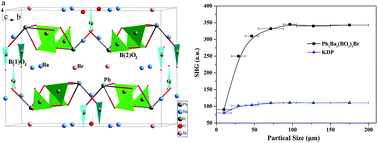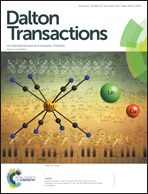Synthesis and optical properties of the first lead borate bromide with isolated BO3 groups: Pb2Ba3(BO3)3Br†
Abstract
Single crystals of a new compound Pb2Ba3(BO3)3Br have been grown by a spontaneous crystallization method. They crystallize in the noncentrosymmetric orthorhombic space group C2221 with isolated BO3 triangles and distorted PbO polyhedra. UV-Vis-NIR diffused reflectance spectroscopy measurements indicate that the absorption edge is at 326 nm. Second-harmonic generation (SHG) measurements using 1064 nm radiation show that Pb2Ba3(BO3)3Br exhibits relative large NLO response about 3.1× that of KH2PO4 (KDP) and is type I phase-matchable. First-principles electronic structure calculations show that the isolated BO3 groups and PbO4 polyhedra play an important role in the total SHG response.


 Please wait while we load your content...
Please wait while we load your content...